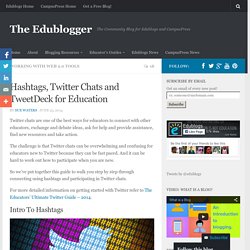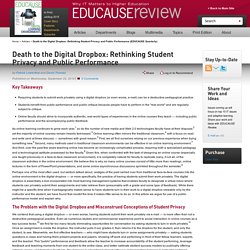

Hashtags, Twitter Chats and TweetDeck for Education. Twitter chats are one of the best ways for educators to connect with other educators, exchange and debate ideas, ask for help and provide assistance, find new resources and take action.

The challenge is that Twitter chats can be overwhelming and confusing for educators new to Twitter because they can be fast paced. And it can be hard to work out how to participate when you are new. So we’ve put together this guide to walk you step by step through connecting using hashtags and participating in Twitter chats. For more detailed information on getting started with Twitter refer to The Educators’ Ultimate Twitter Guide – 2014. Intro To Hashtags A hashtag is any word on twitter that starts with the “#” hash (pound) sign. Hash tags make it easier to search and follow the twitter conversations on specific topics.
How it works is everyone agrees to use a standard hash tag in their tweets when they tweet about a specific topic. Here are some of the commonly used educational hashtags: 1. 2. 3. 4. 6. 1. What is Web 2.0.pdf. 9780262515016_Open_Access_Edition.pdf. The Teacher's Guide To Twitter. Twitter has proven itself to be an indispensable tool for educators around the globe.

Whatever skill level you may be, Twitter is downright fun and worth your time. So here’s a useful guide that we curated from Edudemic’s archives in an effort to put something together that was a bit easier to read than random blog posts. We hope you enjoy and will be regularly adding to this guide so feel free to leave your ideas down in the comments or by, what else, tweeting us @edudemic anytime! Our Biggest Twitter Tips For Teachers For many teachers making a foray into the edtech world, Twitter is an excellent tool for consuming and learning. Many are also harnessing Twitter as a part of their PLN (personal learning network) to connect, share, and network. Check out our biggest Twitter tips for teachers below!
Create, Don’t Just Consume The best way to get the most out of Twitter is to use it. Connect and Network Share Your Resources Keep At It. The Barriers To Using Social Media In Education (Part 1 of 2) - Edudemic. By Pulkit[1] on May 2, 2014@ “When you step away from the prepackaged structure of traditional education, you’ll discover that there are many more ways to learn outside school than within.

" - Kio Start In this article, we have analysed the impact of Social Media[5] on the education sector while also empathizing with educators on their resistance to the use of it in the classroom. We will then look at few classic real classroom examples of how teachers, students and administrators are harnessing social media[6] to create a better learning environment and reforming public education. Social Media As A Key Driver of Communication Social media[7] is often seen as the key driver of communications and marketing. In 2012-13, The US department of Commerce ranked 55 industry sectors for their IT intensiveness, education ranked lowest (below coal mining). We’re not talking about the number of machines lying in your computer lab or iPads in the classroom.
Why Resistance? Respect Privacy Critical Thinking. Authenticity in TESOL (Teaching English to Speakers of Other Languages) Death to the Digital Dropbox: Rethinking Student Privacy and Public Performance. Key Takeaways Requiring students to submit work privately using a digital dropbox (or even worse, e-mail) can be a destructive pedagogical practice.

Students benefit from public performance and public critique because people have to perform in the "real world" and are regularly subject to critique. Online faculty should strive to incorporate authentic, real-world types of experiences in the online courses they teach — including public performance and the accompanying public feedback. Perhaps one of the most often used, but seldom talked about, vestiges of the past carried over from traditional face-to-face courses into the online environment is the digital dropbox — or more specifically, the practice of having students submit their work privately. The Problem with the Digital Dropbox and Misconstrued Conceptions of Student Privacy Private feedback has its place in education.12 We contend, however, that the vast majority of feedback can and should be public. Privacy Figure 1.
Figure 2. Tools Directory. National VET E-learning Strategy. Learning management systems (LMS) Integrated course management tool for training organisations to deliver content, conduct collaborative activities and track learner progress Samples Stonemasonry case study An e-learning implementation model (More details…) Basic/Advanced Training “Moodling Around: A Virtual Tour (Basic)” A two-part presentation on Moodle™ (More details…) Why use learning management systems?

An LMS is a high-level, strategic solution for planning, delivering, and managing most learning events within an organisation, and the selection and deployment of an LMS learning solution needs to be carefully considered. When considering the use of an LMS: What learner information do you want the LMS to track? Features The characteristics shared by most LMSs include: Almost all systems now support IMS or SCORM content packaging and SCORM runtime.